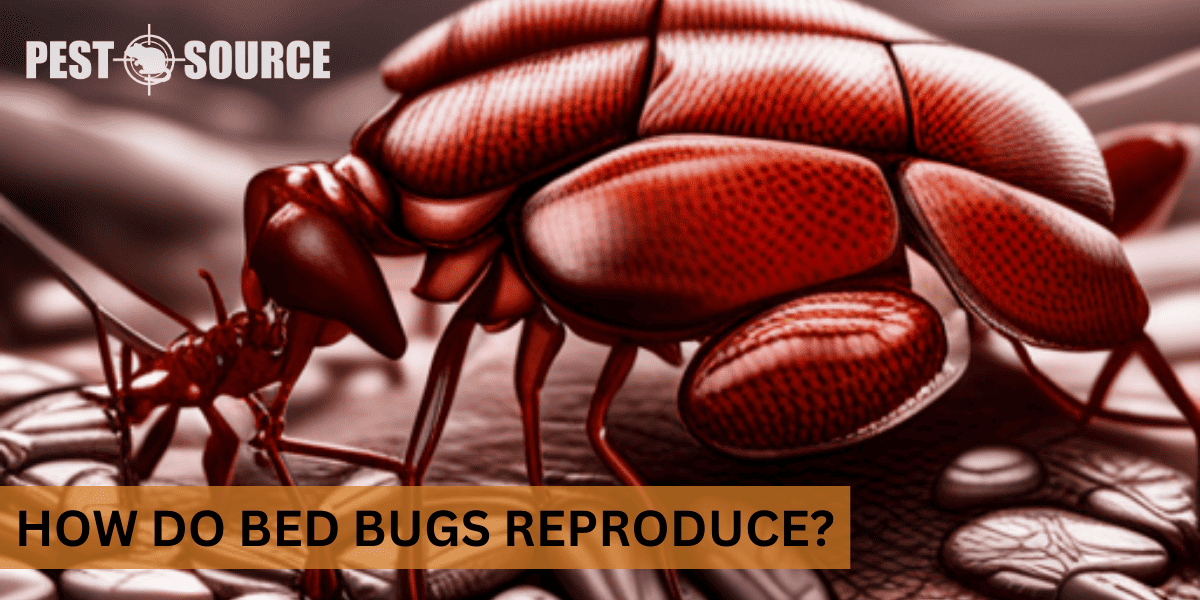Bed bugs reproduce through a process called traumatic insemination, where the male pierces the female’s abdomen to inject sperm directly into her body cavity. Females can lay one to five eggs per day, resulting in a rapid increase in population if not controlled. For more details on the reproductive cycle of bed bugs and the implications for infestation, continue reading the full article.
POINTS
- Bed bugs reproduce through a unique process called traumatic insemination, where the male bed bug pierces the female’s body wall and injects sperm. The female can lay up to 50 eggs in her lifetime.
- A single female bed bug can lay an average of up to five eggs per day after a blood meal. This rapid rate of reproduction can lead to a significant infestation in a short time.
- Bed bugs cannot reproduce without a mate, emphasizing the need for both male and female bed bugs to increase their population. Breaking the mating and breeding cycle is key to mitigating an infestation.
- Proper pest control involves more than just exterminating adult bugs. It’s essential to deal with eggs and nymphs since a single surviving female bed bug can lay hundreds of eggs, potentially reviving a seemingly eradicated infestation.
- Understanding the reproductive habits of bed bugs is crucial for effective pest control. Armed with this knowledge, homeowners can identify signs of a growing infestation and employ the right control methods to prevent a minor bed bug problem from escalating into a major outbreak.
What is the Reproduction Process of Bed Bugs?
The process of bed bug reproduction is unusual and quite fascinating. Bed bugs don’t reproduce in a standard way, like most insects do. Instead, they use a unique method known as traumatic insemination.
What is the Process of Bed Bug Reproduction?
Traumatic insemination involves the male bed bug piercing the female’s body wall with its reproductive organ. The male then introduces its sperm into the female abdomen. From there, the sperm travel through the female’s body, locating her eggs to fertilize them.
How Often Do Bed Bugs Reproduce?
Bed bugs are prolific breeders. Their rapid reproductive cycle only takes about two weeks, allowing an infestation to grow very quickly from just a few initial bugs.
How Do Bed Bugs Mate?
As aforementioned, bed bugs mate using a rather violent process known as traumatic insemination. The male drives its aedeagus, a needle-like sexual organ, into the female’s body – not into a mating canal as many species do.
How Many Eggs Can a Female Bed Bug Lay in Her Lifetime?
A female bed bug can lay up to 50 eggs in her short lifetime. These eggs are miniature, only about the size of a grain of rice, and have a white or translucent color. After being deposited, they generally hatch within about 10 days, starting a new cycle of widespread infestations.
Can Bed Bugs Reproduce Asexually?
You may wonder if bed bugs need to mate to reproduce, or if a single bed bug can cause an infestation. Let’s explore how bed bugs reproduce to understand whether there’s any truth to these worrisome thoughts.
Are Bed Bugs Asexual?
No, bed bugs are not asexual. Both male and female are required for reproduction. However, the reproductive process of bed bugs, traumatic insemination, is different from many other insects.
Can a Single Bed Bug Reproduce?
No, a single bed bug on its own cannot reproduce. Both a male and female bed bug are necessary for reproduction to occur. Thus, a solitary bug is more of a nuisance than a threat of an infestation.
Can Bed Bugs Reproduce Asexually?
No, bed bugs cannot reproduce asexually. They require input from both a male and female for the reproductive process.
Can Bed Bugs Reproduce Without a Mate?
No, bed bugs cannot reproduce without a mate. A female cannot create offspring by herself.
Can a Female Bed Bug Reproduce Without a Male?
No, a female bed bug cannot reproduce without a male. Just as with many other species, a female bed bug needs sperm from a male bed bug to fertilize her eggs.
What is the Role of Mating in Bed Bug Reproduction?
The process of mating in bed bug reproduction is fascinating but brutal. In fact, the term ‘traumatic insemination’ is named for the high costs it incurs on females’ physical well-being.
Do Bed Bugs Need a Mate to Reproduce?
Yes, bed bugs require a mate to reproduce. Males carry sperm, while females carry eggs. The process of reproduction requires both; neither sex can reproduce on their own.
Can Male Bed Bugs Reproduce?
Male bed bugs cannot independently reproduce – they need a female partner. The male’s role in reproduction is to inseminate the female, enabling her to produce fertile eggs.
Do Female Bed Bugs Need a Male to Reproduce?
Yes, female bed bugs need males to reproduce. While females are the ones producing the eggs, they cannot produce viable offspring without the males’ sperm.
Can a Female Bed Bug Lay Eggs Without Mating?
No, a female bed bug cannot lay fertilized eggs without mating. For a female to produce eggs that will hatch into nymphs, she must mate with a male and be inseminated. Without this, the eggs she lays will not lead to any offspring.
How Many Offsprings Do Bed Bugs Produce?
Understanding how many offsprings a bed bug can produce helps provide insight into how quickly infestations can grow, making it easier to plan effective pest control strategies.
How Many Eggs Does a Bed Bug Lay Per Day?
A mature female bed bug can lay an average of up to five eggs per day. Given the right conditions and ample feeding opportunities, her egg production can reach an astonishing total.
How Many Eggs Can a Bed Bug Lay in its Lifetime?
Over her lifespan, which typically lasts about a year, a female bed bug can lay up to 50 eggs. These numbers reveal why a minor bed bug issue can rapidly escalate into a major infestation if not addressed promptly.
How Often Does a Bed Bug Lay Eggs?
A bed bug doesn’t lay eggs daily. It’s after a blood meal when the female produces and lays her eggs. The process happens repeatedly throughout her life, contributing to a steadily increasing population.
How Do Bed Bugs Get Pregnant?
Bed bugs get pregnant through the process of traumatic insemination. The male bed bug pierces the female bed bug’s abdomen with his aedeagus and deposits his sperm, which travel through her body to fertilize the eggs.
How to Identify a Pregnant Bed Bug?
With the threat that a pregnant bed bug poses, knowing how to identify one is vital in implementing bug control mechanisms.
How to Tell if a Bed Bug is Pregnant?
It can be difficult to tell if a bed bug is pregnant by just looking. However, an increase in size and a darker color after a blood meal could be an indication of an engorged, egg-laying female.
What Are the Characteristics of a Pregnant Female Bed Bug?
Pregnant female bed bugs share the typical bed bug shape – oval and flat. After feeding and becoming pregnant, they swell noticeably and darken in color.
What Does a Pregnant Bed Bug Look Like?
A pregnant bed bug looks larger and darker than non-pregnant bugs due to the blood meal they’ve ingested and the fertilized eggs they carry. They often have a more elongated body compared to males and non-pregnant females.
What is the Life Cycle of Bed Bugs, from Egg to Adult?
Understanding how long bed bugs live and their life cycle is key to effective control and prevention. It provides insight into when the bugs are most vulnerable, helping you to target your control efforts appropriately.
What is the Bed Bug Gestation Period?
Once fertilized, bed bug eggs hatch within about 6-10 days depending on the temperature and environment. Each egg hatches into a nymph, which is a juvenile stage of a bed bug.
How Long Does it Take for a Bed Bug’s Eggs to Hatch?
Bed bug eggs typically hatch within a week or so, again this can vary with conditions. Once hatched, nymphs start feeding on blood immediately.
How Are Bed Bugs Born?
Bed bugs are not born in a traditional sense. They hatch from tiny, rice-sized eggs and enter the nymph stage, which is the first step of their life cycle. They must feed and molt multiple times before becoming adults.
How Many Babies Do Bed Bugs Have?
Given ideal conditions, a female bed bug can lay up to 50 eggs in her lifetime. Considering that almost all of these can grow into reproducing adults, the potential expansion of a bed bug population is quite alarming.
How long can bed bugs live without a host?
Bed bugs can live without a host for a surprisingly long time. Adult bed bugs can survive without feeding for up to a year under optimal conditions. However, younger nymphs need to feed more frequently and may only survive a few months without a meal. This resilience, combined with their high reproductive rate, makes them particularly persistent pests.
What is the Impact of Reproduction on Bed Bug Populations?
Reproduction has a significant impact on bed bug populations. By understanding this, you lend yourself the best chance at containing an infestation.
What is the Bed Bug Reproduction Rate?
The reproduction rate of bed bugs is high. A single female can lay up to 50 eggs in her lifetime, and these eggs can hatch and grow to maturity within about a month. This means that a small bed bug infestation can grow rapidly if not dealt with promptly.
Can Bed Bugs Reproduce on Their Own?
No, bed bugs cannot reproduce on their own. They require a partner for reproduction, with females needing males to inseminate them.
Do Bed Bugs Have Queens That Significantly Influence Reproduction?
Unlike some insect species, such as ants or bees, bed bugs do not have a queen that influences reproduction. All mature females are capable of laying eggs and contributing to the population growth.
What is the Social Structure of a Bed Bug Colony?
Bed bugs do not have a complex social structure like some insects. They don’t have a hive or a colony structure, instead, they tend to congregate in what is known as a ‘bed bug harborage.’ Here, they live together in a cluster until feeding or mating takes place.
Each bed bug behaves individually, and their basic behaviors are driven by the need for survival – feeding, mating, and seeking shelter. It’s their high reproduction rate and ability to hide that help them quickly build a significant population within dwellings.



